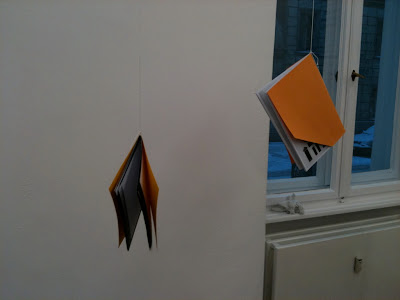













VANITY FAIR
by William M Thackeray
Illustrated by Donald Urquhart
Published by Four Corner Books
Vanity Fair is book number six in the Familiars series (where contemporary artists are invited to produce a new edition of a classic novel or short story) and has been created by British artist Donald Urquhart. Vanity Fair follows the fortunes of its strong-minded and strong-willed anti-heroine Becky Sharp through early 19th century British society.
The images, inspired by 1930s Hollywood star Bette Davies, focus exclusively on Becky Sharp. “I wanted to sideline all the secondary characters,” says Urquhart. “The way that I’ve done it, the chapters she’s not in, there’s no pictures."
As with all of the books in the series, the original text of the novel is included complete, and newly typeset. The text is set in Perpetua and Felicity (partly chosen for their feminine names), two typefaces designed by Eric Gill.
Vanity Fair: A Novel without a Hero is a novel by William Makepeace Thackeray, first published in 1847–48, satirizing society in early 19th-century Britain. The book's title comes from John Bunyan's allegorical story The Pilgrim's Progress, first published in 1678 and still widely read at the time of Thackeray's novel. Vanity fair refers to a stop along the pilgrim's progress: a never-ending fair held in a town called Vanity, which is meant to represent man's sinful attachment to worldly things.
Becky Sharp is the anti-heroine, and Amelia's opposite, she's an intelligent young woman with a gift for satire. She is described as a petite sandy haired girl who has green eyes and a great deal of wit. Fluent in both French and English, Becky has a beautiful singing voice, plays the piano, and shows great talent as an actress. She is also completely amoral and without conscience. She does not seem to have the ability to get attached to other people, and lies easily and intelligently to get her way. She is extremely manipulative and, after the first few chapters and her failure to attract Jos Sedley, is not shown as being particularly sincere. Never having known financial or social security even as a child, Becky desires it above all things. Nearly everything she does is with the intention of securing a stable position for herself, or herself and her husband after she and Rawdon are married. She advances Rawdon's interests tirelessly, flirting with men such as General Tufto and the Marquis of Steyne in order to get him promoted. She also uses her feminine wiles to distract men at card parties while Rawdon cheats them blind. Marrying Rawdon Crawley in secret was a mistake, as was running off instead of begging Miss Crawley's forgiveness. She also fails to manipulate Miss Crawley through Rawdon so as to obtain an inheritance. Although Becky manipulates men very easily, she does not even try to cultivate the friendship of most women. Lady Jane, the Dobbin sisters, and Lady Steyne see right through her. Amelia and (initially) Miss Crawley are exceptions to the rule.
"I first read Vanity Fair some 20 years ago, I discovered that one of my literary heroes, Dorothy Parker, would read the book regularly each year up to the point where poor sweet Amelia's faithless husband lies dead with a bullet through his heart. Why she stopped there I will never know, but I could clearly see how Thackeray's sophisticated humour would appeal to her as a model for her own razor-sharp prose. I have lost count of how many times I have enjoyed the serious pleasures of this book and am thrilled that I have been able to make illustrations for it." Donald Urquhart
VANITY FAIR
by William M Thackeray
Illustrated by Donald Urquhart
Published by Four Corner Books
Hardback.
848 pages
40 illustrations
230 x 165mm.
ISBN 978-0-9561928-4-4
£16.99
Buy it live at the great price of £15 cash, directly from
Four Corner Books at Raven Row Gallery, or order it online from
Amazon.co.uk
http://www.fourcornersbooks.co.uk/vanityfair.html











































































